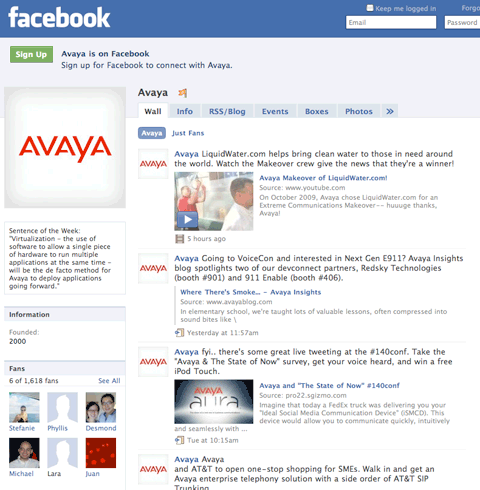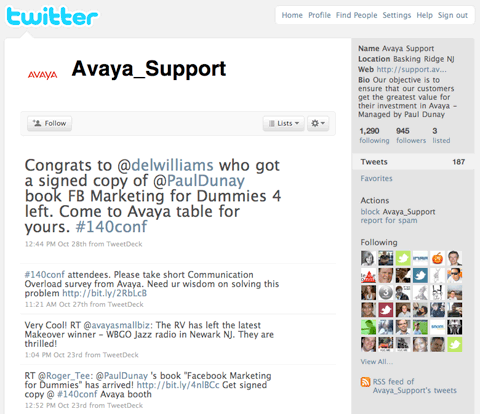Avaya can hear you. Maybe you just praised the communications giant online – or took its name in vain. Whatever you said, it’s on the company’s radar.
At a time when businesses are using social media to promote content and start discussions, Avaya has found that listening trumps talking.
“We’re listening to social media and responding,” said Paul Dunay, Avaya’s social media ringleader, who is global managing director of services and social media marketing.
“There is no Tweet that goes unturned. No forum post that goes unturned where our name is mentioned.”
What began as a way to engage and support customers has evolved beyond even Avaya’s expectations. And if Avaya ever doubted its investment in social media, those concerns are now put to rest.
A recent quarter-million–dollar sale, which began on Twitter, soundly answered that question.
Organization:
- Avaya – http://www.avaya.com/usa/
- Facebook – 42 groups + 5 new fan pages
- Blogs – 1 Avaya external blog; 14 internal Avaya blogs
- Wikis – 15 internal
- Twitter – 10 global accounts
- LinkedIn – 12 groups
- Yammer – ~3000 employees
- Socialcast – recently launched
- 50 virtual team members volunteer to monitor 1,000–2,500 mentions of Avaya online every week.
- A single Twitter post led to a $250K sale 13 days later.
- Avaya proactively intercepts many support issues before the customer ever logs a formal support request.
Making the Case
Avaya started in 2000 as a spinoff of Lucent Technologies, but its legacy goes back more than a century to the original Bell system. From the earliest phone systems to advanced, unified communications, Avaya and its predecessors have been – and continue to be – at the forefront of the field.
It makes sense then that Avaya would be wherever people are communicating today. The company’s social media activity started informally and grew organically. First, it was mostly a matter of supporting – and keeping – existing customers, many of whom need replacements as old phone systems are retired.
At the time, Dunay followed Avaya mentions on Twitter, which were mostly questions that he forwarded to support reps.
“The old 1.0 way was a call center or inputting tickets on the web,” he said. “2.0 is we’ll try to reach out to Avaya support which is, by the way, me on Twitter.”
With the growth of social media, those mentions soon became too much for Dunay to simply watch on his own. He brought his case to Avaya’s CMO, and left with official backing to build a cross-functional, global, and virtual social media team.
“It was very easy for me to build my business case on retention of existing customers because it’s so expensive to get new ones,” he said
Take-Aways from Avaya
1. Be where your customers are.“92% of B2B technology buyers consider themselves engaging in some form of social media,” Dunay says.
2. Engage early adopter employees.
Find and engage employees who are excited about and experienced in using social media.
3. Don’t automate responses.
Personalized interaction isn’t personal if it’s automated. Social media participants expect real people and real responses.
4. Listen more than you talk.
Listen first, and join the conversation second. Be on top of all relevant mentions, or find technology that can.
5. Don’t just track your company’s name.
Look for conversations on related topics and contribute if you can add value.
Customer Conversations ‘Everywhere’
Through word of mouth, Dunay found early social media adopters within Avaya’s 15,000 employees, starting with seven people across communications, marketing, support, legal and other business units. As the team began organizing Avaya’s social media strategy, they chose to focus on four main tools: Facebook, blogging, forums and Twitter.
From there, Avaya’s social media was “literally an explosion,” according to Dunay. That team of seven employees has now grown to 50 – all of whom volunteer to participate in social media on top of their regular jobs.
Today, the company has 42 Facebook groups, five Facebook fan pages, one external blog with 10 regular Avaya writers, 10 global Twitter accounts, and 12 LinkedIn groups. Internally, Avaya leverages social media just as much, with 14 internal blogs, 15 wikis, about 3,000 employees on Yammer and some on the recently launched Socialcast.
Facebook serves as the hub, with events, news, discussions and links to blog posts. The blogs discuss trends, innovations and cultural insights. Twitter allows them to post quick bits of information, respond to support requests, and monitor mentions of the brand and competition. Forums enable customers to get help from each other or from Avaya tech support.
With significant momentum, Dunay reported back to the CMO. “She asked, ‘Where are we talking to customers?’ I said, ‘Everywhere!’ She asked, ‘Where are we holding conversations with partners?’ I said, ‘Everywhere!’ We’re holding all the conversations in the same places with each one of those constituencies – and then some.”

Contests, videos and other resources engage Avaya’s Facebook fans.
The Eyes and Ears of Avaya
With active listening as the team’s main approach, members found they simply couldn’t be everywhere at all times – especially as mentions of the Avaya name grew to between 1,000 and 2,500 weekly. They turned to Radian6 technology to listen to and measure all social media mentions of not just the company’s name, but competitors’ names, product names, and types of conversations.
“We identified conversations we wanted to go deeply into,” Dunay said. “Wherever conversations about small business and communications happen, we need to be there.”
Avaya tracks a dashboard of mentions, and can choose to either ignore or respond to each. When one member “hears” something requiring further action, he or she posts it on an internal wiki and it’s assigned to someone on the relevant team to address it. That might be support, billing and finance, engineering, a partner, and so forth.
Dunay stresses that none of Avaya’s responses are automated. Who knows what a customer or prospect might say? If your response isn’t tailored to their comments, then you’ve missed the opportunity to connect on a personal level.
The 58-Character Sale
On average, Avaya interacts with a couple of dozen customers through social media on a weekly basis. By listening, the team also comes across sales opportunities. In June of this year, 58 characters of a simple Tweet started the relationship with a potential customer.
“shoretel or avaya? Time for a new phone system very soon,” the Tweet read.
“In less than maybe 15 minutes, we had seen it and figured out what the heck to say to this guy,” Dunay said. “I wrote back, ‘We have some highly trained techs who can help you understand your needs best and help you make an objective decision. Give me a call.’”
Dunay referred the gentleman to a business partner, and 13 days later, they closed a $250,000 sale. At the same time, the new customer’s follow-up Tweet went out: “…we have selected AVAYA as our new phone system. Excited by the technology and benefits…”
“We were there. We were listening. It pays to listen,” Dunay said. “I can’t say we hit 100% of the conversations where we’ve wanted to be, although it’s probably 60–70%. But on our brand name, it is 117%. We’re on every one of those.”

Avaya proactively identifies and responds to support issues using Twitter.
One Tweet Away
By proactively looking for mentions and conversations, Avaya sees issues before they even arise, before anyone contacts the company. A response to a social media mention truly makes an impression on customers, prospects and partners. “We are the early response center for things happening in the marketplace,” Dunay said. “They love knowing you’re one Tweet away.”
Avaya’s social media team grew quickly, but Dunay has an even bigger vision for social media.
“I don’t think it should be 50. I think it should be 15,000. Everyone should have a hand in it,” Dunay said. “We definitely want more people deeper and broader in the organization.”
“Our goals are to have deeper, more interesting and more pervasive conversations with as many people as we possibly can,” he added. “Why wouldn’t you take every opportunity for your brand to build better and deeper relations with every customer you can?”
No comments:
Post a Comment